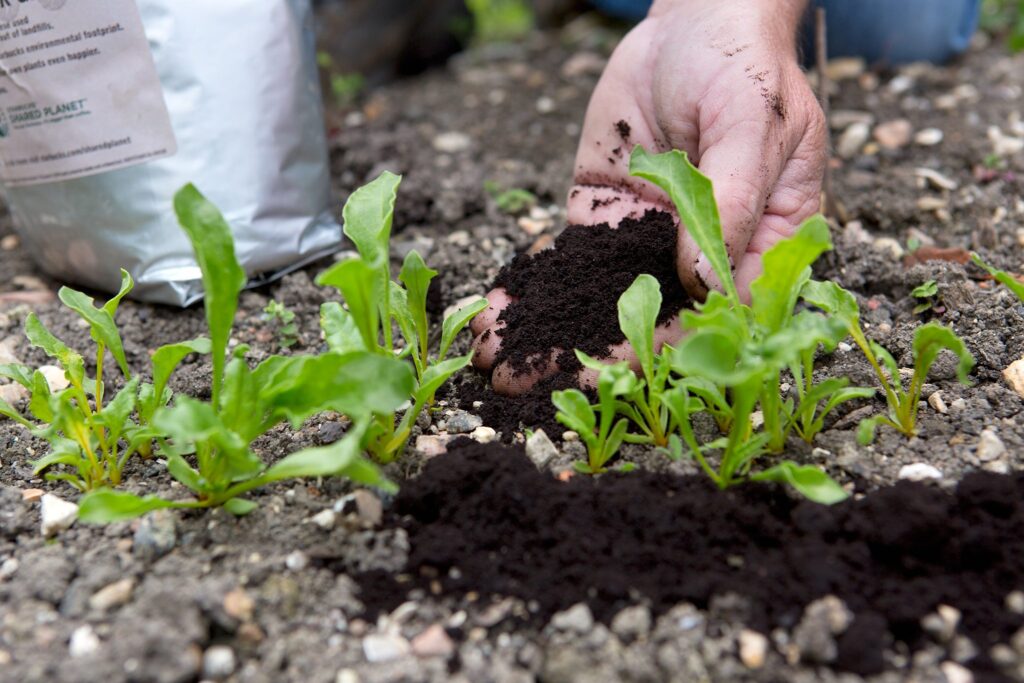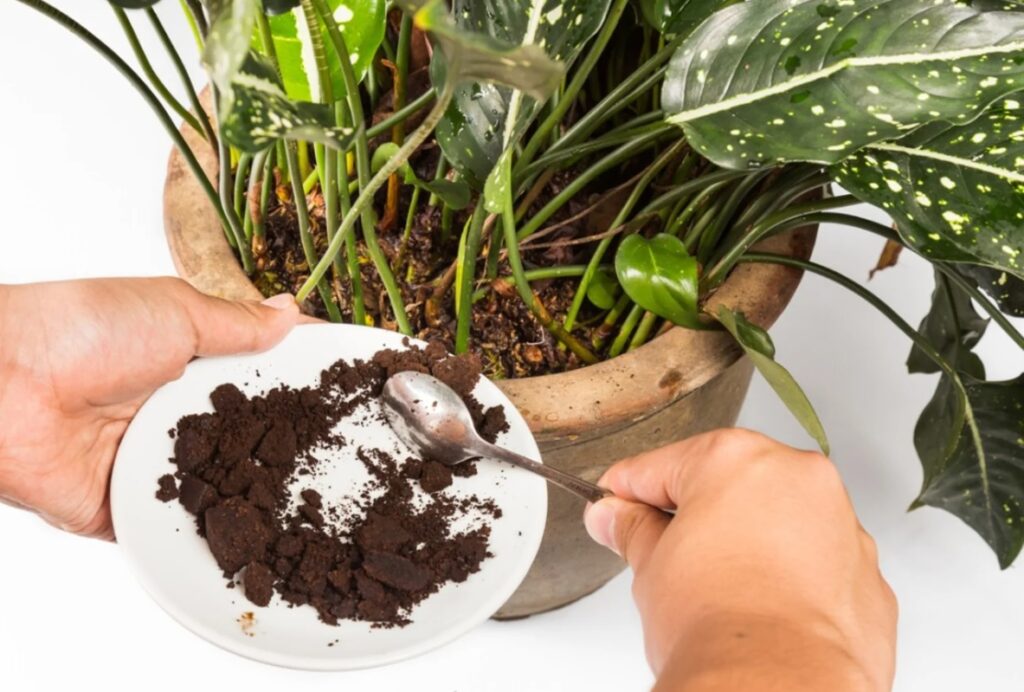
What to do with Coffee grounds? Put coffee grounds in the garden? Does adding used grounds from your morning coffee to your garden soil help or hurt?
Have you noticed, down at your favorite coffee house, bags of used coffee (Starbucks has them)? Have you tried putting coffee grounds in compost? How about using coffee grounds on plants as fertilizer? Is it a good idea?
Don’t even think of throwing away those used grounds of Java! Fresh coffee grounds are just as valuable as the coffee you make from them.
Below are 7 ways how to use coffee grounds in the garden.
Coffee Grounds As Mulch

If you ever wanted to know – Are coffee grounds good for the garden? The answer is yes! Coffee grounds make excellent ground mulch, especially for acid-loving plants.
What plants like coffee grounds? Plants like:
- Blueberry bushes or blueberries
- Huckleberry
- Holly bushes
- Azaleas
- Rhododendrons
- Juneberry
- Fragrant gardenia trees
- Flowering Camellias
- Trillium grandiflorum
- Begonias
- Hydrangeas
- Lilies
- Hollies
It’s a bit ironic, but the dark brown remains of your morning coffee will turn your hydrangea flowers bright blue!
Evergreen trees are also fond of acidic potting soil. Here are a few trees that like coffee grounds:
- Flowering dogwood trees
- Magnolia trees
- Willow oaks
- Beech trees
Garden vegetables that prefer slightly acidic soil include:
- Peppers (all types)
- Radishes
- Sweet potatoes
- Eggplant
- Tomato plants
- Parsley
- Rhubarb
- Carrots
- Potatoes (even though the soils in Idaho are predominantly alkaline).
When you mulch with coffee, spread a layer about one-half inch thick, or your grounds will mold too readily, and they could make your soil too acidic.
Add Used Coffee Grounds For Plants And Your Compost Pile
Mixing or adding coffee grounds to soil is a good way to build the soil structure. It also helps in aeration, water retention, and drainage.
The perfect place to start is to add coffee filters and coffee grounds directly with grass clippings to the worm bin or compost pile.
Why are coffee grounds good for plants? Coffee is a good source of nitrogen (contains 1.5% by weight), and you can include it in the plant’s nutrition thru compost coffee grounds.
Adding used coffee grounds to compost (coffee filters, too) puts nitrogen fertilizer into your compost soil.
However, it is also important to keep in mind the acidity of coffee grounds. Balance this out with yard scraps, kitchen food scraps, and a good source of calcium carbonates like wood ashes or lime to balance the pH and add more phosphorous.
Keep in mind that the fungus growing on coffee tends to use up a lot of nitrogen. Again, it’s a good idea to have a good mixture of organic matter and other materials in your compost bin or compost heap.
#3 – Used Coffee Grounds For Plants Offers A Ring Of Protection
Are slugs and snails attacking your strawberries? Snails munching on your lettuce in the vegetable garden? Are ants eating your tomatoes?
Apart from using coffee grounds for soil amendment, you can also use coffee grounds for plant protection, like a moat protects a castle.
Place a protective ring of used coffee grounds around these vulnerable plants. Or try adding diatomaceous earth to control pests.
Slugs, snails, worms, and other common garden pests dislike the smell, acidity, caffeine content, or texture of coffee grounds and are repelled by them.
Best of all, using this simple, all-natural solution can help you avoid using any toxic pesticides around your food!
Coffee Grounds For Fertilizer – Free, Effective, and Easy To Make Liquid Fertilizer

Coffee grounds contain nutrients like nitrogen, phosphorus, potassium, copper, and magnesium.
Roses are one of the plants that like coffee grounds! Backyard flower growers like to use coffee grounds for roses as the used grounds still contain a high concentration of these nutrients.
It is very easy to use coffee grounds as organic fertilizer by making an effective liquid food. Put about one-half pound of used coffee grinds in a five-gallon bucket, fill it with water, and stir.
You can also simply sprinkle the coffee grounds directly onto the soil surface of your garden.
Let this sit for a few days to allow the nutrients from the coffee to seep into the water. The resulting brew is your liquid fertilizer.
This is an excellent alternative to store-bought chemical fertilizers containing harmful chemicals like petrochemicals, arsenic, and cadmium.
Of course, unlike store-bought liquid fertilizers, your homemade liquid fertilizer is free!
It also makes an excellent foliar feed spray that can be applied directly on the leaves and plant stems.
Using Coffee Grounds In The Garden To Stain Your Garden Benches
After creating a beautiful edible organic garden, the last thing you need is a varnished or painted garden bench, leaching toxic chemicals into your soil every time it rains or you water your garden!
An easy solution is to use natural coffee grounds to stain your garden benches. Use coffee grounds to give a beautiful sepia color that will not contaminate your garden.
What Can Coffee Grounds Be Used For – Shoo Away the Neighbor Cats
Humans and cats don’t always think alike. While we relish the smell of fresh ground coffee beans and freshly brewed coffee, cats are repelled by the same coffee aroma!
Thus, if you have some neighborhood kitties (or your own cats) digging up your garden, try spreading some coffee grinds in the soil or around the edge of your garden!
Final Tip
If you don’t drink coffee at home or are not a coffee drinker enough to supply your garden soil and plants, many coffee shops like Starbucks give their fresh grounds away for free!
You could also ask any local coffee shop or restaurant you patronize to save their coffee grounds for you, and they’d likely oblige you.
You can thank them later by bringing them some beautiful fresh flowers or garden-fresh vegetables.
